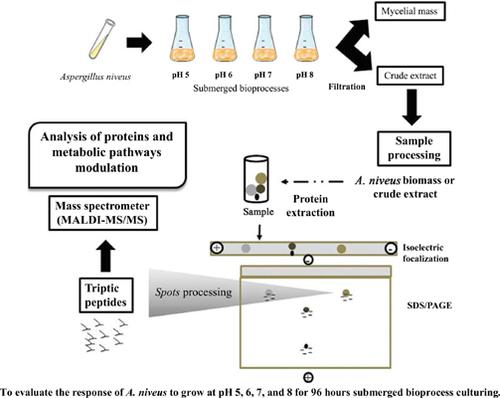Current Proteomics ( IF 0.8 ) Pub Date : 2021-07-31 , DOI: 10.2174/1570164617999201202120657 Juliana Abigail Leite 1 , Nathalia Gonsales da Rosa-Garzon 1 , Helen Julie Laure 2 , José Cesar Rosa 2 , Octavio Luiz Franco 3 , Cristina Maria de Souza Motta 4 , Hamilton Cabral 1

|
Background: Proteomics facilitates understanding the complexity of molecular and physiological mechanisms involved in the metabolic and biological fungal adaptations to pH changes. Proteomics enables the identification of enzymes and fungal proteins involved in these adaptations. This approach may be used to investigate such fungi as Aspergillus niveus, whose proteome has not yet been analyzed, changes the intra- and extracellular protein profiles in response to extracellular pH.
Objective: In the current study, we used two-dimensional gel electrophoresis (2DE) and mass spectrometry to evaluate the response of A. niveus to grow at pH 5, 6, 7, and 8 for 96 hours submerged bioprocess culturing.
Methods: This study evaluated the response of A. niveus to grow at pH 5, 6, 7, and 8 for 96 h submerged bioprocess culturing, by analysis of two-dimensional gel electrophoresis (2DE), of the intracellular proteomes and the secretome, protein spots of interest were submitted to tryptic digestion and analyzed by matrix-assisted laser desorption/ionization time-of-flight tandem mass spectrometry (MALDI-TOF/TOF-MS).
Results: This approach revealed substantial differences between the functions of intra- and extracellular proteins of A. niveus. The data suggested that pH-modulated global proteins are involved in important, mainly metabolic, processes, in the pentose phosphate pathway, protein regulation, cell wall maintenance, and others. Moreover, the change in extracellular pH could have altered the availability of nutrients, and induced the production of enzymes that respond to oxidative and other stresses.
Conclusion: Proteomic facilitates understanding of the complexity of molecular and physiological mechanisms involved in the metabolic and biological adaptations of fungi to pH changes.
中文翻译:

不同pH条件下水下生物过程培养过程中黑曲霉胞内和胞外蛋白的蛋白质组学分析
背景:蛋白质组学有助于理解代谢和生物真菌对 pH 变化的适应所涉及的分子和生理机制的复杂性。蛋白质组学能够鉴定参与这些适应的酶和真菌蛋白。这种方法可用于研究诸如 Aspergillus niveus 之类的真菌,其蛋白质组尚未分析,可响应细胞外 pH 值改变细胞内和细胞外蛋白质谱。
目的:在目前的研究中,我们使用二维凝胶电泳 (2DE) 和质谱法来评估 A. niveus 在 pH 5、6、7 和 8 下进行 96 小时的浸没生物过程培养的响应。
方法:本研究通过对细胞内蛋白质组和分泌组的二维凝胶电泳 (2DE) 分析,评估了 A. niveus 在 pH 5、6、7 和 8 下对 96 小时水下生物过程培养的反应,将感兴趣的蛋白质点进行胰蛋白酶消化,并通过基质辅助激光解吸/电离飞行时间串联质谱法 (MALDI-TOF/TOF-MS) 进行分析。
结果:这种方法揭示了 A. niveus 的细胞内和细胞外蛋白质的功能之间的实质性差异。数据表明,pH 调节的全局蛋白质参与重要的,主要是代谢过程、戊糖磷酸途径、蛋白质调节、细胞壁维护等。此外,细胞外 pH 值的变化可能改变了营养物质的可用性,并诱导了对氧化和其他压力作出反应的酶的产生。
结论:蛋白质组学有助于理解真菌对 pH 变化的代谢和生物学适应所涉及的分子和生理机制的复杂性。


























 京公网安备 11010802027423号
京公网安备 11010802027423号